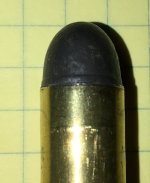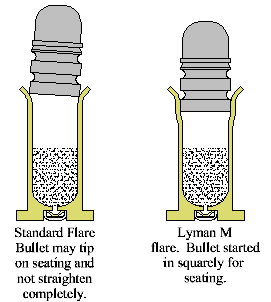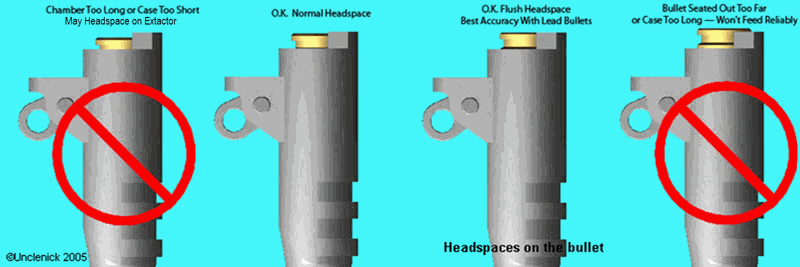DesertRatR
New member
I am trying to improve my 45 ACP yield. I load on an RCBS Pro 2000 with RCBS with carbide dies (last die is seater/crimper). I am loading 230 gr LRN moly coated bullets with Starline brass and 5.5 gr Unique. The photo shows one of my inert set up rounds, with the shoulder above the case mouth. The shoulder is about 0.050” high. I have been getting about 90% yield, by that I mean 90% or so of what comes out of the press drops nicely into my case gage. A couple per cent won’t go into the gage all the way, protruding anywhere from 1/4” or more out of the gage, so I download them and reload. The rest will go into the gage, but protrude above the gage a few mils. When I look at those under magnification I can see the shoulder on the bullet is a bit mangled, and that keeps the round from properly head spacing. Using a pick and brush I can clean up the lead and smooth it out so that the round then head spaces properly. Those rounds all feed and shoot properly after cleanup, but it is an extra step that is a bit time consuming.
I am attributing the yield problem to the bullet not being quite vertical going into the die, and the die not straightening it out. That is only a guess, though. Is there a better die that would straighten the bullet if it is a bit cock-eyed? BTW, my bell allows about 1/8” or so of the bullet into the case mouth.
The other option I can think of is to seat the bullet 0.050” deeper, and move the shoulder just to the case mouth. I use the Speer loading manual. Their data for 230 gr LRN is for 1.270” OAL. I am at 1.265”, 0.4% reduced volume. I’ve loaded anywhere from 0.3% low to 1.5% low and all chronograph (I usually chronograph 60 at a time) at 808 ft/s with SD of 18 ft/s. Speer’s max load velocity is 849 ft/s. Seating the bullet 0.050” deeper is 4.5% volume reduction. I think I can reduce the load and sneak up on a safe load. What is the risk in loading shorter and sneaking up on load?
I forgot to roll the bad rounds to check for wobble. But I just rolled my 6 inert set up rounds and none wobble.
If my idea of the bullet being cock-eyed doesn’t make sense, any suggestions to improve yield with out clean up work?
I am attributing the yield problem to the bullet not being quite vertical going into the die, and the die not straightening it out. That is only a guess, though. Is there a better die that would straighten the bullet if it is a bit cock-eyed? BTW, my bell allows about 1/8” or so of the bullet into the case mouth.
The other option I can think of is to seat the bullet 0.050” deeper, and move the shoulder just to the case mouth. I use the Speer loading manual. Their data for 230 gr LRN is for 1.270” OAL. I am at 1.265”, 0.4% reduced volume. I’ve loaded anywhere from 0.3% low to 1.5% low and all chronograph (I usually chronograph 60 at a time) at 808 ft/s with SD of 18 ft/s. Speer’s max load velocity is 849 ft/s. Seating the bullet 0.050” deeper is 4.5% volume reduction. I think I can reduce the load and sneak up on a safe load. What is the risk in loading shorter and sneaking up on load?
I forgot to roll the bad rounds to check for wobble. But I just rolled my 6 inert set up rounds and none wobble.
If my idea of the bullet being cock-eyed doesn’t make sense, any suggestions to improve yield with out clean up work?



